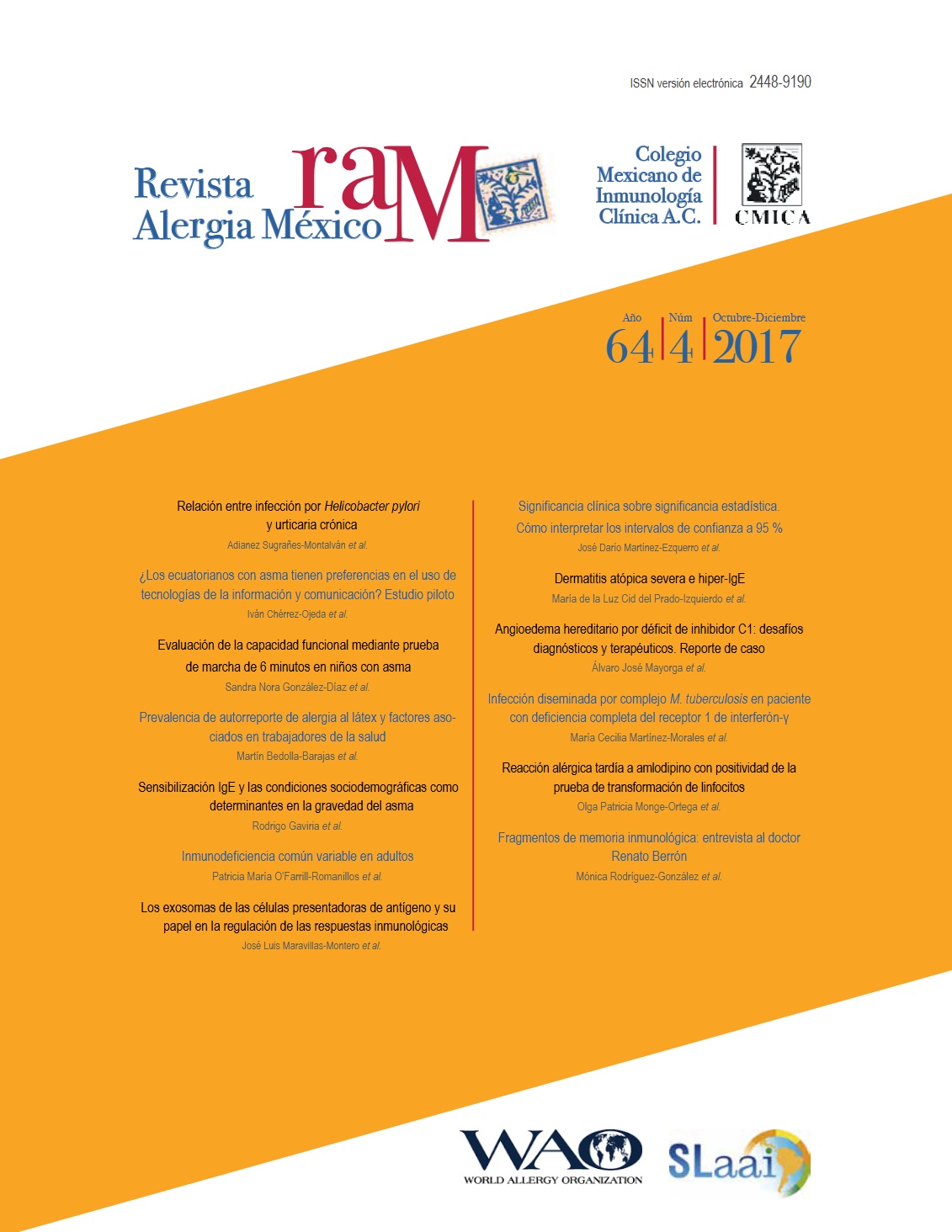Resumen
Antecedentes: La comunicación inadecuada entre los pacientes y sus médicos puede interferir directamente con el control del asma. En los últimos años, el uso de tecnologías de la información y comunicación se ha incrementado en Latinoamérica y parece ser un recurso útil para mejorar la comunicación, adherencia y control del paciente con asma.
Objetivo: evaluar la frecuencia y patrones de preferencia de las tecnologías de comunicación e información en pacientes ecuatorianos con asma bronquial.
Métodos: estudio transversal en el que se utilizó la versión en español del cuestionario Michigan. La edad y el nivel educacional fueron categorizados en 3 grupos. Se utilizó regresión logística entre los grupos respecto a la frecuencia de uso e interés en buscar y recibir información relacionada con el asma, según la edad y nivel educacional.
Resultados: en nuestro estudio participaron 222 pacientes. La edad media fue de 45.6 ± 17.4 años y el sexo más común fue el femenino, con 89.25 %. Casi todos los pacientes tenían teléfono celular (87.5 %) y acceso a internet (62.7 %). Las tres tecnologías de la información y comunicación con mayor probabilidad de ser usadas con fines de buscar o recibir información acerca de la enfermedad fueron WhatsApp, Facebook y correo electrónico (p < 0.05).
Conclusión: el correo electrónico y los mensajes de texto fueron preferidos por los pacientes, sin embargo, WhatsApp y Facebook pueden ser apropiados para ciertos grupos, especialmente para los jóvenes. La selección de TIC adecuadas para la comunicación médico-paciente podría mejorar la adherencia y el control de los pacientes con asma.
Referencias
Croisant S. Epidemiology of Asthma: Prevalence and burden of disease. En: Brasier AR, editor. Heterogeneity in asthma. EUA: Springer; 2014.
Masoli M, Fabian D, Holt S, Beasley R, Global Initiative for Asthma Program. The global burden of asthma: executive summary of the GINA Dissemination Committee report. Allergy. 2004;59(5):469-478. DOI: http://dx.doi.org/10.1111/j.1398-9995.2004.00526.x
Gold LS, Montealegre F, Allen‐Ramey FC, Jardim J, Smith N, Sansores R, et al. Level of asthma control and healthcare utilization in Latin America. Allergy. 2013;68(11):1463-1466. DOI: http://dx.doi.org/10.1111/all.12237.
Bender BG, Bender SE. Patient-identified barriers to asthma treatment adherence: responses to interviews, focus groups, and questionnaires. Immunol Allergy Clin North Am. 2005;25(1):107-130. DOI: http://dx.doi.org/10.1016/j.iac.2004.09.005
Nathan RA, Thompson PJ, Price D, Fabbri LM, Salvi S, González-Díaz S, et al. Taking aim at asthma around the world: global results of the asthma insight and management survey in the Asia-Pacific region, Latin America, Europe, Canada, and the United States. J Allergy Clin Immunol Pract. 2015;3(5):734.e5-742.e5. DOI: http://dx.doi.org/10.1016/j.jaip.2015.04.013
Chérrez-Ojeda I, Calderón JC, Mori J, Colombaro D, Braido F, Soria E, et al. Patient-physician relationship in the management of asthma: Multicentric approach in Latin America. J Asthma. 2016;53(7):751-760. DOI: http://dx.doi.org/10.3109/02770903.2016.1145691
Jiménez-Pernett J, García-Gutiérrez JF, Martín-Jiménez JL, Bermúdez-Tamayo C. Tendencias en el uso de Internet como fuente de información sobre salud. UOC Papers. 2007(4):44-50. Disponible en: http://www.redalyc.org/articulo.oa?id=79000411
Perron BE, Taylor HO, Glass JE, Margerum-Leys J. Information and communication technologies in social work. Adv Soc Work. 2010;11(2):67-81.
Buse DC, Lipton RB. Facilitating communication with patients for improved migraine outcomes. Curr Pain Headache Rep. 2008;12(3):230-236.
Lombardi C, Passalacqua G, Canonica GW. The WEB-based Asthma Control: an intriguing connection or a dangerous hazard? Asthma Res Pract. 2015;1(1):15. DOI: http://dx.doi.org/10.1186/s40733-015-0017-z
Baptist AP, Thompson M, Grossman KS, Mohammed L, Sy A, Sanders GM. Social media, text messaging, and email-preferences of asthma patients between 12 and 40 years old. J Asthma. 2011;48(8):824-830. DOI: http://dx.doi.org/10.3109/02770903.2011.608460
Sperber AD. Translation and validation of study instruments for cross-cultural research. Gastroenterology. 2004;126 Suppl 1:S124-S128. DOI: http://dx.doi.org/10.1053/j.gastro.2003.10.016
Naciones Unidas/CEPAL. [Sitio web]. Estado de la banda ancha en América Latina y el Caribe 2016. Serie Documentos de Proyectos núm. 710; 2016. Disponible en: http://repositorio.cepal.org/handle/11362/40528
Pew Research Center. [Sitio web]. Smith A. U. S. smartphone use in 2015. [Actualizado 2015 Abr 1]. http://www.pewinternet.org/2015/04/01/us-smartphone-use-in-2015/
Thakkar J, Kurup R, Laba TL, Santo K, Thiagalingam A, Rodgers A, et al. Mobile telephone text messaging for medication adherence in chronic disease: A meta-analysis. JAMA Intern Med. 2016;176(3):340-349. DOI: http://dx.doi.org/10.1001/jamainternmed.2015.7667
Kaplan WA. Can the ubiquitous power of mobile phones be used to improve health outcomes in developing countries? Global Health. 2006;2(1):9. DOI: http://dx.doi.org/10.1186/1744-8603-2-9
Chretien KC, Kind T. Social media and clinical care: Ethical, professional, and social implications. 2013;127(13):1413-1421. DOI: http://dx.doi.org/10.1161/CIRCULATIONAHA.112.128017
Chou W-YS, Hunt YM, Beckjord EB, Moser RP, Hesse BW. Social media use in the United States: Implications for health communication. J Med Internet Res. 2009;11(4):e48. DOI: http://dx.doi.org/10.2196/jmir.1249
Hanson CL, West J, Thackeray R, Barnes MD, Downey J. Understanding and predicting social media use among community health center patients: A cross-sectional survey. J Med Internet Res. 2014;16(11):e270. DOI: http://dx.doi.org/10.2196/jmir.3373
GlobalWebIndex. [Sitio web]. Young K. WhatsApp usage highest in LatAm. GlobalWebIndex. The trends to watch in 2017. Reino Unido: GlobalWebIndex; 2016. Disponible en: https://blog.globalwebindex.net/chart-of-the-day/whatsapp-usage-highest-in-latam/

Esta obra está bajo una licencia internacional Creative Commons Atribución-NoComercial 4.0.
Derechos de autor 2017 Revista Alergia México

